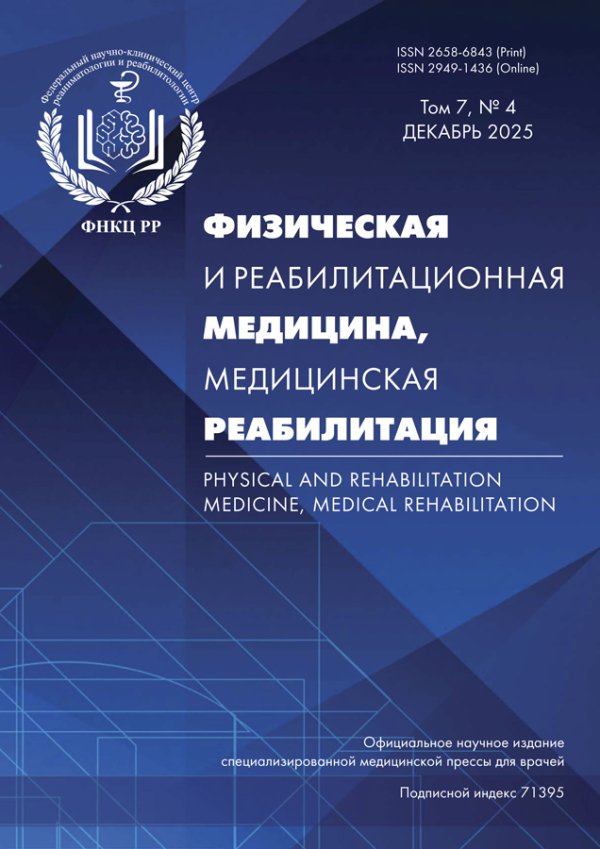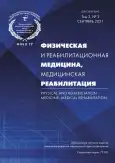Cerebral palsy biomarker
- Authors: Kamilova T.A.1, Golota A.S.1, Vologzhanin D.A.1,2, Shneider O.V.1, Sсherbak S.G.1,2
-
Affiliations:
- Saint Petersburg City Hospital No 40
- Saint-Petersburg State University
- Issue: Vol 3, No 3 (2021)
- Pages: 301-317
- Section: REVIEWS
- URL: https://journal-vniispk.ru/2658-6843/article/view/79386
- DOI: https://doi.org/10.36425/rehab79386
- ID: 79386
Cite item
Full Text
Abstract
Cerebral palsy is a neurological disorder that is attributed to non-progressive injury or malformation that occurred in the developing fetal or infant brain. The motor disorders in cerebral palsy are often accompanied by disturbances of sensation, perception, cognition, communication, behaviour, and by epilepsy. Cerebral palsy is a complex disorder that is likely to be of multifactorial origin. Epidemiological studies have shown that the origins of most CP are prior to labor. A number of clinical risk factors for cerebral palsy have been described in the literature including preterm birth, low birth weight, inflammation, maternal infection during pregnancy and placenta pathology. Hypoxia at birth may be primary or secondary to preexisting pathology, but the currently known clinical risk factors do not explain the majority of cases. Many of these risk factors may have a genetic component. Several single nucleotide polymorphisms, DNA copy number variations and epigenetic patterns increase genetic susceptibility for cerebral palsy. Whole genome sequencing and gene expression studies may extend the percentage of cases with a genetic pathway. Clinical risk factors could act as triggers for CP where there is genetic susceptibility. These new findings should refocus research about the causes of these complex and varied neurodevelopmental disorders on the search for biomarkers of the risk of cerebral palsy. Genomics, proteomics and metabolomics have huge potential for deepening our understanding of many complex diseases by identifying diagnostic and prognostic panels of biomarkers, especially in various neurological disorders, including cerebral palsy.
Full Text
##article.viewOnOriginalSite##About the authors
Tatyana A. Kamilova
Saint Petersburg City Hospital No 40
Email: kamilovaspb@mail.ru
ORCID iD: 0000-0001-6360-132X
SPIN-code: 2922-4404
Cand. Sci. (Biol.)
Russian Federation, 9B Borisova st., Sestroretsk, Saint Petersburg, 197706Aleksandr S. Golota
Saint Petersburg City Hospital No 40
Author for correspondence.
Email: golotaa@yahoo.com
ORCID iD: 0000-0002-5632-3963
SPIN-code: 7234-7870
MD, Cand. Sci. (Med.), Associate Professor
Russian Federation, 9B Borisova st., Sestroretsk, Saint Petersburg, 197706Dmitry A. Vologzhanin
Saint Petersburg City Hospital No 40; Saint-Petersburg State University
Email: volog@bk.ru
ORCID iD: 0000-0002-1176-794X
SPIN-code: 7922-7302
MD, Dr. Sci. (Med.)
Russian Federation, 9B Borisova st., Sestroretsk, Saint Petersburg, 197706; Saint PetersburgOlga V. Shneider
Saint Petersburg City Hospital No 40
Email: o.shneider@gb40.ru
ORCID iD: 0000-0001-8341-2454
SPIN-code: 8405-1051
MD, Cand. Sci. (Med.)
Russian Federation, 9B Borisova st., Sestroretsk, Saint Petersburg, 197706Sergey G. Sсherbak
Saint Petersburg City Hospital No 40; Saint-Petersburg State University
Email: b40@zdrav.spb.ru
ORCID iD: 0000-0001-5047-2792
SPIN-code: 1537-9822
MD, Dr. Sci. (Med.), Professor
Russian Federation, 9B Borisova st., Sestroretsk, Saint Petersburg, 197706; Saint PetersburgReferences
- Li EY, Zhao PJ, Jian J, et al. Vitamin B1 and B12 mitigates neuron apoptosis in cerebral palsy by augmenting BDNF expression through MALAT1/miR-1 axis. Cell Cycle. 2019;18(21):2849–2859. doi: 10.1080/15384101.2019.1638190
- Magalhães RC, Moreira JM, Lauar AO, et al. Inflammatory biomarkers in children with cerebral palsy: A systematic review. Res Dev Disabil. 2019;95:103508. doi: 10.1016/j.ridd.2019.103508
- Crowgey EL, Marsh AG, Robinson KG, et al. Epigenetic machine learning: utilizing DNA methylation patterns to predict spastic cerebral palsy. BMC Bioinformatics. 2018; 19(1):225. doi: 10.1186/s12859-018-2224-0
- Jia J, Shi X, Jing X, et al. BCL6 mediates the effects of gastrodin on promoting M2-like macrophage polarization and protecting against oxidative stress-induced apoptosis and cell death in macrophages. Biochem Biophys Res Commun. 2017;486(2):458–464. doi: 10.1016/j.bbrc.2017.03.062
- Tonni G, Leoncini S, Signorini C, et al. Pathology of perinatal brain damage: Background and oxidative stress markers. Arch Gynecol Obstet. 2014;290(1):13–20. doi: 10.1007/s00404-014-3208-6
- Wimalasundera N, Stevenson VL. Cerebral palsy. Pract Neurol. 2016;16(3):184–194. doi: 10.1136/practneurol-2015-001184
- Novak CM, Ozen M, Burd I. Perinatal brain injury: mechanisms, prevention, and outcomes. Clin Perinatol. 2018;45(2):357–375. doi: 10.1016/j.clp.2018.01.015
- Pascal A, Govaert P, Oostra A, et al. Neurodevelopmental outcome in very preterm and very-low-birthweight infants born over the past decade: a meta-analytic review. Dev Med Child Neurol. 2018;60(4):342–355. doi: 10.1111/dmcn.13675
- Bennet L, Dhillon S, Lear CA, et al. Chronic inflammation and impairment development of the preterm brain. J Reprod Immunol. 2018;125:45–55. doi: 10.1016/j.jri.2017.11.003
- Alpay Savasan Z, Yilmaz A, Ugur Z, et al. Metabolomic profiling of cerebral palsy brain tissue reveals novel central biomarkers and biochemical pathways associated with the disease: a pilot study. Metabolites. 2019;9(2):E27. doi: 10.3390/metabo9020027
- Korzeniewski SJ, Slaughter J, Lenski M, et al. The complex aetiology of cerebral palsy. Nat Rev Neurol. 2018;14(9): 528–543. doi: 10.1038/s41582-018-0043-6
- Yli BM, Kjellmer I. Pathophysiology of foetal oxygenation and cell damage during labour. Best Pract Res Clin Obstet Gynaecol. 2016;30:9–21. doi: 10.1016/j.bpobgyn.2015.05.004
- Fahey MC, Maclennan AH, Kretzschmar D, et al. The genetic basis of cerebral palsy. Dev Med Child Neurol. 2017;59(5):462–469. doi: 10.1111/dmcn.13363
- MacLennan AH, Thompson SC, Gecz J. Cerebral palsy: causes, pathways, and the role of genetic variants. Am J Obstet Gynecol. 2015;213(6):779–788. doi: 10.1016/j.ajog.2015.05.034
- McMichael G, Bainbridge MN, Haan E, et al. Whole-exome sequencing points to considerable genetic heterogeneity of cerebral palsy. Mol Psychiatry. 2015;20(2):176–182. doi: 10.1038/mp.2014.189
- Mohandas N, Bass-Stringer S, Maksimovic J, et al. Epigenome-wide analysis in newborn blood spots from monozygotic twins discordant for cerebral palsy reveals consistent regional differences in DNA methylation. Clin Epigenetics. 2018;10:25. doi: 10.1186/s13148-018-0457-4
- Cho KH, Xu B, Blenkiron C, Fraser M. Emerging roles of miRNAs in brain development and perinatal brain injury. Front Physiol. 2019;10:227. doi: 10.3389/fphys.2019.00227
- Chapman SD, Farina L, Kronforst K, Dizon M. MicroRNA profile differences in neonates at risk for cerebral palsy. Phys Med Rehabil Int. 2018;5(3):1148.
- Ahearne CE, Boylan GB, Murray DM. Short and long term prognosis in perinatal asphyxia: an update. World J Clin Pediatr. 2016;5(1):67–74. doi: 10.5409/wjcp.v5.i1.67
- Ravishankar S, Redline RW. The placenta. Handb Clin Neurol. 2019;162:57–66. doi: 10.1016/B978-0-444-64029-1.00003-5
- Bolnick JM, Kohan-Ghadr HR, Fritz R, et al. Altered biomarkers in trophoblast cells obtained noninvasively prior to clinical manifestation of perinatal disease. Sci Rep. 2016; 6:32382. doi: 10.1038/srep32382
- Fleiss B, Gressens P. Tertiary mechanisms of brain damage: a new hope for treatment of cerebral palsy? Lancet Neurol. 2012;11(6):556–566. doi: 10.1016/S1474-4422(12)70058-3
- Wu J, Li X. Plasma tumor necrosis factor-alpha (TNF-α) levels correlate with disease severity in spastic diplegia, triplegia, and quadriplegia in children with cerebral palsy. Med Sci Monit. 2015;21:3868–3874. doi: 10.12659/msm.895400
- Yanni D, Korzeniewski SJ, Allred EN, et al. Both antenatal and postnatal inflammation contribute information about the risk of brain damage in extremely preterm newborns. Pediatr Res. 2017;82(4):691–696. doi: 10.1038/pr.2017.128
- Leifsdottir K, Mehmet H, Eksborg S, Herlenius E. Fas-ligand and interleukin-6 in the cerebrospinal fluid are early predictors of hypoxic-ischemic encephalopathy and long-term outcomes after birth asphyxia in term infants. J Neuroinflammation. 2018;15(1):223. doi: 10.1186/s12974-018-1253-y
- Jiao Z, Jiang Z, Wang J, et al. Whole-genome scale identification of methylation markers specific for cerebral palsy in monozygotic discordant twins. Mol Med Rep. 2017; 16(6):9423–9430. doi: 10.3892/mmr.2017.7800
- Rajatileka S, Odd D, Robinson M, et al. Variants of the EAAT2 glutamate transporter gene promoter are associated with cerebral palsy in preterm infants. Mol Neurobiol. 2018;55(3):2013–2024. doi: 10.1007/s12035-017-0462-1.
- Wang H, Xu Y, Chen M, et al. Genetic association study of adaptor protein complex 4 with cerebral palsy in a Han Chinese population. Mol Biol Rep. 2013;40(11):6459–6467. doi: 10.1007/s11033-013-2761-6
- Shi W, Zhu Y, Zhou M, et al. Malectin gene polymorphisms promote cerebral palsy via M2-like macrophage polarization. Clin Genet. 2018;93(4):794–799. doi: 10.1111/cge.13149
- O’Callaghan ME, Maclennan AH, Gibson CS, et al.; Australian Collaborative Cerebral Palsy Research Group. Genetic and clinical contributions to cerebral palsy: a multi-variable analysis. J Paediatr Child Health. 2013;49(7):575–581. doi: 10.1111/jpc.12279
- Shang Q, Zhou C, Liu D, et al. Association between osteopontin gene polymorphisms and cerebral palsy in a chinese population. Neuromolecular Med. 2016;18(2):232–238. doi: 10.1007/s12017-016-8397-7
- Chernykh ER, Kafanova MY, Shevela EY, et al. Clinical experience with autologous M2 macrophages in children with severe cerebral palsy. Cell Transplant. 2014; 23(Suppl 1):S97–104. doi: 10.3727/096368914X684925
- Wu T, Li X, Ding Y, et al. Seven patients of argininemia with spastic tetraplegia as the first and major symptom and prenatal diagnosis of two fetuses with high risk. Zhonghua Er Ke Za Zhi. 2015;53(6):425–430.
- Diaz Heijtz R, Almeida R, Eliasson AC, Forssberg H. Genetic variation in the dopamine system influences intervention outcome in children with cerebral palsy. EBioMedicine. 2018;28:162–167. doi: 10.1016/j.ebiom.2017.12.028
- Looney AM, Walsh BH, Moloney G, et al. Downregulation of umbilical cord blood levels of miR-374a in neonatal hypoxic ischemic encephalopathy. J Pediatr. 2015;167(2): 269–273.e2. doi: 10.1016/j.jpeds.2015.04.060
- Whitehead CL, Teh WT, Walker SP, et al. Circulating microRNAs in maternal blood as potential biomarkers for fetal hypoxia in-utero. PLoS One. 2013;8(11):e78487. doi: 10.1371/journal.pone.0078487
- Denihan NM, Boylan GB, Murray DM. Metabolomic profiling in perinatal asphyxia: a promising new field. Biomed Res Int. 2015;2015:254076. doi: 10.1155/2015/254076
- Gao J, Zhao B, He L, et al. Risk of cerebral palsy in chinese children: A matched case control study. J Paediatr Child Health. 2017;53:464–469. doi: 10.1111/jpc.13479
- Benavente-Fernandez I, Ramos-Rodriguez JJ, Infante-Garcia C, et al. Altered plasma-type gelsolin and amyloid-β in neonates with hypoxic-ischaemic encephalopathy under therapeutic hypothermia. J Cereb Blood Flow Metab. 2019;39(7):1349–1354. doi: 10.1177/0271678X18757419
- Shin YK, Yoon YK, Chung KB, et al. Patients with non-ambulatory cerebral palsy have higher sclerostin levels and lower bone mineral density than patients with ambulatory cerebral palsy. Bone. 2017;103:302–307. doi: 10.1016/j.bone.2017.07.015
- Lv H, Wang Q, Wu S, et al. Neonatal hypoxic ischemic encephalopathy-related biomarkers in serum and cerebrospinal fluid. Clin Chim Acta. 2015;450:282–297. 10.1016/j.cca.2015.08.021
- Hansen SL, Lorentzen J, Pedersen LT, et al. Suboptimal nutrition and low physical activity are observed together with reduced plasma brain-derived neurotrophic factor (BDNF) concentration in children with severe cerebral palsy (CP). Nutrients. 2019;11(3):E620. doi: 10.3390/nu11030620
- Koh H, Rah WJ, Kim YJ, et al. Serial changes of cytokines in children with cerebral palsy who received intravenous granulocyte-colony stimulating factor followed by autologous mobilized peripheral blood mononuclear cells. J Korean Med Sci. 2018;33(21):e102. doi: 10.3346/jkms.2018.33.e102
- Tao W, Lu Z, Wen F. The influence of neurodevelopmental treatment on transforming growth factor-β1 levels and neurological remodeling in children with cerebral palsy. J Child Neurol. 2016;31(13):1464–1467. doi: 10.1177/0883073816656402
Supplementary files








